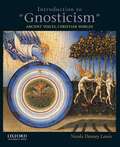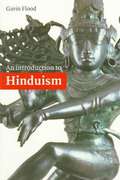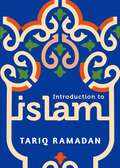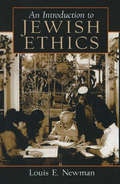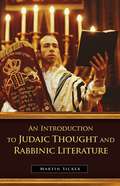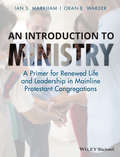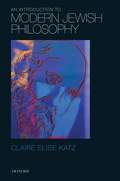- Table View
- List View
An Introduction to Engaged Buddhism
by Paul FullerThis textbook introduces and explores the ideas, practices and philosophy of engaged Buddhism. The movement holds that suffering is not just caused by the cravings of the mind, but also by political and social factors; therefore, engaged Buddhists 'engage' with social issues to achieve liberation. Paul Fuller outlines the movement's origins and principles. He then offers a comprehensive analysis of the central themes and issues of engaged Buddhism, offering new insights into the formation of modern Buddhism. The range of issues covered includes politics, gender, environmentalism, identity, blasphemy and violence. These are illustrated by case studies and examples from a range of locations where Buddhism is practised. Discussion points and suggested further reading are provided at the end of each chapter, which will further enrich undergraduates' grasp of the topic.
An Introduction to German Pietism: Protestant Renewal at the Dawn of Modern Europe (Young Center Books in Anabaptist and Pietist Studies)
by Douglas H. ShantzAn Introduction to German Pietism provides a scholarly investigation of a movement that changed the history of Protestantism. The Pietists can be credited with inspiring both Evangelicalism and modern individualism.Taking into account new discoveries in the field, Douglas H. Shantz focuses on features of Pietism that made it religiously and culturally significant. He discusses the social and religious roots of Pietism in earlier German Radicalism and situates Pietist beginnings in three cities: Frankfurt, Leipzig, and Halle. Shantz also examines the cultural worlds of the Pietists, including Pietism and gender, Pietists as readers and translators of the Bible, and Pietists as missionaries to the far reaches of the world. He not only considers Pietism's role in shaping modern western religion and culture but also reflects on the relevance of the Pietist religious paradigm of today.The first survey of German Pietism in English in forty years, An Introduction to German Pietism provides a narrative interpretation of the movement as a whole. The book's accessible tone and concise portrayal of an extensive and complex subject make it ideal for courses on early modern Christianity and German history. The book includes appendices with translations of German primary sources and discussion questions.
An Introduction to Hegel's Lectures on the Philosophy of Religion: The Issue of Religious Content in the Enlightenment and Romanticism
by Jon StewartAn Introduction to Hegel's Lectures on the Philosophy of Religion examines Hegel's religious thinking by seeing it against the backdrop of the main religious trends in his own day, specifically the Enlightenment and Romanticism. A basic introduction to Hegel's lectures, it provides an account of the criticism of religion by key Enlightenment thinkers such as Voltaire, Lessing, Hume, and Kant. This is followed by an analysis of how the Romantic thinkers, such as Rousseau, Jacobi and Schleiermacher, responded to these challenges. For Hegel, the views of these thinkers from both the Enlightenment and Romanticism tended to empty religion of its content. The goal that he sets for his own philosophy of religion is to restore this lost content. The book provides a detailed account of Hegel's Lectures on the Philosophy of Religion and argues that the basic ideas of the Enlightenment and Romanticism are still present today, and remain an important issue for both academics and non-academics, regardless of their religious orientation.
An Introduction to Hegel's Lectures on the Philosophy of Religion: The Issue of Religious Content in the Enlightenment and Romanticism
by Jon StewartAn Introduction to Hegel's Lectures on the Philosophy of Religion examines Hegel's religious thinking by seeing it against the backdrop of the main religious trends in his own day, specifically the Enlightenment and Romanticism. A basic introduction to Hegel's lectures, it provides an account of the criticism of religion by key Enlightenment thinkers such as Voltaire, Lessing, Hume, and Kant. This is followed by an analysis of how the Romantic thinkers, such as Rousseau, Jacobi and Schleiermacher, responded to these challenges. For Hegel, the views of these thinkers from both the Enlightenment and Romanticism tended to empty religion of its content. The goal that he sets for his own philosophy of religion is to restore this lost content. The book provides a detailed account of Hegel's Lectures on the Philosophy of Religion and argues that the basic ideas of the Enlightenment and Romanticism are still present today, and remain an important issue for both academics and non-academics, regardless of their religious orientation.
An Introduction to Hinduism (PDF)
by Gavin FloodThis book provides a much-needed thematic and historical introduction to Hinduism, the religion of the majority of people in India. Dr Flood traces the development of Hindu traditions from their ancient origins, through the major deities of Visnu, Siva and the Goddess, to the modern world. Hinduism is discussed as both a global religion and a form of nationalism. Emphasis is given to the tantric traditions, which have been so influential; to Hindu ritual, which is more fundamental to the life of the religion than are specific beliefs or doctrines; and to Dravidian influences from south India. An Introduction to Hinduism examines the ideas of dharma, particularly in relation to the ideology of kingship, caste and world renunciation. Dr Flood also introduces some debates within contemporary scholarship about the nature of Hinduism. It is suitable both for the student and for the general reader.
An Introduction to Indian Philosophy: Perspectives on Reality, Knowledge, and Freedom
by Bina GuptaAn Introduction to Indian Philosophy offers a profound yet accessible survey of the development of India’s philosophical tradition. Beginning with the formation of Brāhmaṇical, Jaina, Materialist, and Buddhist traditions, Bina Gupta guides the reader through the classical schools of Indian thought, culminating in a look at how these traditions inform Indian philosophy and society in modern times. Offering translations from source texts and clear explanations of philosophical terms, this text provides a rigorous overview of Indian philosophical contributions to epistemology, metaphysics, philosophy of language, and ethics. This is a must-read for anyone seeking a reliable and illuminating introduction to Indian philosophy. Key Updates in the Second Edition Reorganized into seven parts and fifteen chapters, making it easier for instructors to assign chapters for a semester-long course. Continues to introduce systems historically, but focuses on new key questions and issues within each system. Details new arguments, counter-arguments, objections, and their reformulations in the nine schools of Indian philosophy. Offers expanded discussion of how various schools of Indian philosophy are engaged with each other. Highlights key concepts and adds new grey boxes to explain selected key concepts. Includes a new section that problematizes the Western notion of "philosophy." New Suggested Readings sections are placed at the end of each chapter, which include recommended translations, a bibliography of important works, and pertinent recent scholarship for each school. Adds a new part (Part III) that explains the difficulties involved in translating from Sanskrit into English, discusses fundamental concepts and conceptual distinctions often used to present Indian philosophy to Western students, and reviews important features and maxims that most darśanas follow. Provides new examples of applications to illustrate more obscure concepts and principles.
An Introduction to Indian Philosophy: Perspectives on Reality, Knowledge, and Freedom
by Bina GuptaAn Introduction to Indian Philosophy offers a profound yet accessible survey of the development of India’s philosophical tradition. Beginning with the formation of Brāhmaṇical, Jaina, Materialist, and Buddhist traditions, Bina Gupta guides the reader through the classical schools of Indian thought, culminating in a look at how these traditions inform Indian philosophy and society in modern times. Offering translations from source texts and clear explanations of philosophical terms, this text provides a rigorous overview of Indian philosophical contributions to epistemology, metaphysics, philosophy of language, and ethics. This is a must-read for anyone seeking a reliable and illuminating introduction to Indian philosophy. Key Updates in the Second Edition Reorganized into seven parts and fifteen chapters, making it easier for instructors to assign chapters for a semester-long course. Continues to introduce systems historically, but focuses on new key questions and issues within each system. Details new arguments, counter-arguments, objections, and their reformulations in the nine schools of Indian philosophy. Offers expanded discussion of how various schools of Indian philosophy are engaged with each other. Highlights key concepts and adds new grey boxes to explain selected key concepts. Includes a new section that problematizes the Western notion of "philosophy." New Suggested Readings sections are placed at the end of each chapter, which include recommended translations, a bibliography of important works, and pertinent recent scholarship for each school. Adds a new part (Part III) that explains the difficulties involved in translating from Sanskrit into English, discusses fundamental concepts and conceptual distinctions often used to present Indian philosophy to Western students, and reviews important features and maxims that most darśanas follow. Provides new examples of applications to illustrate more obscure concepts and principles.
Introduction to Islam
by Tariq RamadanFrom one of the most prominent intellectuals in the Muslim world comes a timely new introduction to one of the world's most practiced-and most misunderstood-religions. In frank, unapologetic language, Tariq Ramadan walks readers through Islam and its principles, rituals, diversity, and evolution. Ramadan, known for his efforts to reform and change the understanding of Islam in the West, avoids ideology and idealism, instead attempting to depict the true meaning of Islam for readers who have no previous experience with the religion. The book is therefore focused on defining the basic principles of Islam and offering an overview of the faith's history: from its beginnings in prophetic mission, to the Sunni-Shi'a schism, to the formation of distinct schools of law, theology, philosophy, and mysticism. Perhaps the most misinterpreted aspect of Islam, shariah, literally translated as "the way that leads to a source of water," receives an entire chapter of attention. Ramadan explains the ways in which shariah has been reduced by fundamentalism to a mere criminal code and expands upon its place in the larger Islamic worldview. He then confronts some of the most pressing issues facing Muslims today, including gender equality, religious diversity, and violence. Both sensitive and accessible, Introduction to Islam is a much-needed guide to understanding the role of Islam in the modern world.
An Introduction to Islam in the 21st Century
by Aminah Beverly McCloud Scott W. Hibbard Laith SaudThis engaging introduction to Islam examines its lived reality, its worldwide presence, and the variety of beliefs and practices encompassed by the religion. The global perspective uniquely captures the diversity of Islam expressed throughout different countries in the present day. A comprehensive, multi-disciplinary, and global introduction to Islam, covering its history as well as current issues, experiences, and challenges Incorporates key new research on Muslims from a variety of countries across Europe, Latin America, Indonesia, and Malaysia Central Asia Directly addresses controversial issues, including political violence and ‘terrorism’, anti-western sentiments, and Islamophobia Explores different responses from various Islamic communities to globalizing trends Highlights key patterns within Islamic history that shed light upon the origins and evolution of current movements and thought
An Introduction to Islam in the 21st Century
by Aminah Beverly McCloud Scott W. Hibbard Laith SaudThis engaging introduction to Islam examines its lived reality, its worldwide presence, and the variety of beliefs and practices encompassed by the religion. The global perspective uniquely captures the diversity of Islam expressed throughout different countries in the present day. A comprehensive, multi-disciplinary, and global introduction to Islam, covering its history as well as current issues, experiences, and challenges Incorporates key new research on Muslims from a variety of countries across Europe, Latin America, Indonesia, and Malaysia Central Asia Directly addresses controversial issues, including political violence and ‘terrorism’, anti-western sentiments, and Islamophobia Explores different responses from various Islamic communities to globalizing trends Highlights key patterns within Islamic history that shed light upon the origins and evolution of current movements and thought
Introduction to Islamic Banking and Finance (The Wiley Finance Series #594)
by Brian KettellIntroduction to Islamic Banking and Finance is a succinct guide to the key characteristics of Islamic banking highlighting how these differ from conventional banking. This detailed book illustrates how Islamic banking is consistent with the Sharia'a, a key element of which is the prohibition on collecting and paying interest. This central religious precept appears to rule out most aspects of modern finance but it does allow money to be used for trading tangible assets and business, which can then generate a profit. Brian Kettell's book looks at all aspects of Islamic banking, including chapters on its creation and evolution through to detailed discussions of the issues involved in the Sharia'a contracts of Murabaha, Mudaraba, Musharaka, Ijara, Istisna'a, and Salam. Islamic insurance (Takaful) is also covered. Finally the book takes a look at Sharia'a law and Sharia'a boards, indicating the roles and responsibilities that come with membership. Islamic banks have been operating in places such as Bahrain, Saudi Arabia, Malaysia and Dubai for some time. Conventional bankers have traditionally viewed the sector as a small, exotic niche but recent years have seen a dramatic surge in popularity. A number of Western investment banks have started working with Muslim clerics to create new ranges of financial products designed for devout Muslims, a large and growing market. Although estimates of the size of the Islamic finance industry vary greatly, everyone agrees that it is expanding rapidly and this is the perfect book for anyone looking to understand the industry.
Introduction to Islamic Banking and Finance (The Wiley Finance Series #594)
by Brian KettellIntroduction to Islamic Banking and Finance is a succinct guide to the key characteristics of Islamic banking highlighting how these differ from conventional banking. This detailed book illustrates how Islamic banking is consistent with the Sharia'a, a key element of which is the prohibition on collecting and paying interest. This central religious precept appears to rule out most aspects of modern finance but it does allow money to be used for trading tangible assets and business, which can then generate a profit. Brian Kettell's book looks at all aspects of Islamic banking, including chapters on its creation and evolution through to detailed discussions of the issues involved in the Sharia'a contracts of Murabaha, Mudaraba, Musharaka, Ijara, Istisna'a, and Salam. Islamic insurance (Takaful) is also covered. Finally the book takes a look at Sharia'a law and Sharia'a boards, indicating the roles and responsibilities that come with membership. Islamic banks have been operating in places such as Bahrain, Saudi Arabia, Malaysia and Dubai for some time. Conventional bankers have traditionally viewed the sector as a small, exotic niche but recent years have seen a dramatic surge in popularity. A number of Western investment banks have started working with Muslim clerics to create new ranges of financial products designed for devout Muslims, a large and growing market. Although estimates of the size of the Islamic finance industry vary greatly, everyone agrees that it is expanding rapidly and this is the perfect book for anyone looking to understand the industry.
Introduction to Islamic Theology and Law (Modern Classics in Near Eastern Studies)
by Ignaz GoldziherThe book description for the previously published "Introduction to Islamic Theology and Law" is not yet available.
An Introduction to Jewish Ethics
by Louis NewmanFor courses in Religion, Judaism and Ethics. This text offers an overview of the Jewish ethical tradition as it has evolved from biblical times to the present. Provides an overview of the central beliefs of classical Judaism and the ways in which these frame traditional Jewish approaches to issues in ethics, both theoretical and practical.
An Introduction to Jewish Ethics
by Louis NewmanFor courses in Religion, Judaism and Ethics. This text offers an overview of the Jewish ethical tradition as it has evolved from biblical times to the present. Provides an overview of the central beliefs of classical Judaism and the ways in which these frame traditional Jewish approaches to issues in ethics, both theoretical and practical.
An Introduction to Judaic Thought and Rabbinic Literature
by Martin SickerMany people have heard the term Talmud but have little or no idea what it is, what it contains, and why it was written; moreover, few have ever actually looked into one of its works, and even fewer would make any sense of it if they did. Here, Sicker provides readers with insight into the nature and history of Judaic thought and its literature through illustrative examples and clear explanations. Rabbinic literature is important, even to those who are not religiously inclined, because it alone represents the embodiment of the intellectual legacy that has contributed enormously to the survival and continuity of the Jewish people. Through two thousand years of dispersion, rabbinic literature was the primary link to the past and provided hope for the future. It was, in effect, the intellectual homeland of a people scattered throughout the world. Even if one has never read any Judaic literature, he or she will have some notion of what it is after reading this book.This book is written for the vast majority of adults who either attend synagogue or have a general interest in Judaism, whether Jewish or not. It provides insight into the meaning of terms that are used in sermons, lectures, and articles, such as Torah, halakhah, midrash, Talmud, and Jewish law, all of which are component elements of rabbinic literature. Sicker explains the meaning of these and other terms, the bodies of literature they refer to, and the historical linkage between them in an easy, accessible manner. In a sense, this book is not only a guide to the literature, but also an intellectual history of Judaic thought and culture that should be of interest to anyone even slightly curious about how Judaism managed to survive for millennia without central institutions or clerical hierarchy.
An Introduction to Longitudinal Research (Social Research Today)
by Elisabetta RuspiniOne of the major changes in the social science research landscape in recent years has been the introduction of computerised panel surveys in Europe and the US which make longitudinal data widely available to graduate students for the first time. Elisabetta Ruspini here provides a concise yet comprehensive introduction to the issues involved in this kind of research. This book:* Defines the concept of longitudinal research* Gives guidance on sources of longitudinal data in Europe and the US and their strengths and weaknesses* Discusses the choices that need to be made in this kind of research - for instance the advantages and disadvantages of certain types of research data and of different types of analysis* Highlights some of the problems involved, e.g. the issue of comparability within longitudinal research
An Introduction to Longitudinal Research (Social Research Today)
by Elisabetta RuspiniOne of the major changes in the social science research landscape in recent years has been the introduction of computerised panel surveys in Europe and the US which make longitudinal data widely available to graduate students for the first time. Elisabetta Ruspini here provides a concise yet comprehensive introduction to the issues involved in this kind of research. This book:* Defines the concept of longitudinal research* Gives guidance on sources of longitudinal data in Europe and the US and their strengths and weaknesses* Discusses the choices that need to be made in this kind of research - for instance the advantages and disadvantages of certain types of research data and of different types of analysis* Highlights some of the problems involved, e.g. the issue of comparability within longitudinal research
An Introduction to Ministry: A Primer for Renewed Life and Leadership in Mainline Protestant Congregations
by Ian S. Markham Oran E. WarderAn Introduction to Ministry is a comprehensive and ecumenical introduction to the craft of ministry for ministers, pastors, and priests that make up the mainline denominations in the United States. Ecumenically-focused, It offers a grounded account of ministry, covering areas such as vocation, congregational leadership, and cultivation of skills for an effective ministry. Covers the key components of the M.Div. curriculum, offering a map and guide to the central skills and issues in training Explores the areas of vocation, skills for ministry, and issues around congregational leadership Each topic ends with an annotated bibliography providing an indispensable gateway to further study Helps students understand both the distinctive approach of their denomination and the relationship of that approach to other mainline denominations Advocates and defends a generous understanding of the Christian tradition in its openness and commitment to broad conversation
An Introduction to Ministry: A Primer for Renewed Life and Leadership in Mainline Protestant Congregations
by Ian S. Markham Oran E. WarderAn Introduction to Ministry is a comprehensive and ecumenical introduction to the craft of ministry for ministers, pastors, and priests that make up the mainline denominations in the United States. Ecumenically-focused, It offers a grounded account of ministry, covering areas such as vocation, congregational leadership, and cultivation of skills for an effective ministry. Covers the key components of the M.Div. curriculum, offering a map and guide to the central skills and issues in training Explores the areas of vocation, skills for ministry, and issues around congregational leadership Each topic ends with an annotated bibliography providing an indispensable gateway to further study Helps students understand both the distinctive approach of their denomination and the relationship of that approach to other mainline denominations Advocates and defends a generous understanding of the Christian tradition in its openness and commitment to broad conversation
An Introduction to Modern Jewish Philosophy (Introductions To Religion Ser.)
by Claire Elise KatzHow Jewish is modern Jewish philosophy? The question at first appears nonsensical, until we consider that the chief issues with which Jewish philosophers have engaged, from the Enlightenment through to the late 20th century, are the standard preoccupations of general philosophical inquiry. Questions about God, reality, language, and knowledge - metaphysics and epistemology - have been of as much concern to Jewish thinkers as they have been to others. Moses Mendelssohn, for example, was a friend of Kant. Hermann Cohen's philosophy is often described as 'neo-Kantian.' Franz Rosenzweig wrote his dissertation on Hegel. And the thought of Emmanuel Levinas is indebted to Husserl. In this much-needed textbook, which surveys the most prominent thinkers of the last three centuries, Claire Katz situates modern Jewish philosophy in the wider cultural and intellectual context of its day, indicating how broader currents of British, French and German thought influenced its practitioners. But she also addresses the unique ways in which being Jewish coloured their output, suggesting that a keen sense of particularity enabled the Jewish philosophers to help define the whole modern era. Intended to be used as a core undergraduate text, the book will also appeal to anyone with an interest how some of the greatest minds of the age grappled with some of its most urgent and fascinating philosophical problems.
Introduction to New and Alternative Religions in America: [5 volumes]
Most new or alternative religious are gravely misunderstood by members of the religious mainstream. Labeled cults or sects, groups and their members are often ridiculed or otherwise disregarded as weird and potentially dangerous by the populace at large. Despite their efforts at educating the general public, the various anti- and counter-cult activists have in fact promoted much more mis-understanding than accurate understanding of the religious lives of some of their fellow citizens. Consequently, they have helped to create a very hostile environment for anyone whose religious practices do not fit within a so-called mainstream. This set rectifies the situation by presenting accurate, comprehensive, authoritative and accessible accounts of various new and alternative religious movements that have been and are active in American society, and it addresses ways of understanding new and alternative religions within a broader context.Determining what actually constitutes a new or alternative religion is a subject of constant debate. Questions arise as to a new faith's legitimacy, beliefs, methods of conversion, and other facets of a religious movement's viability and place in a given culture. How a religion gains recognition by the mainstream, which often labels such new movements as cults, is fraught with difficulty, tension, and fear. Here, experts delineate the boundaries and examine the various groups, beliefs, movements, and other issues related to new faiths and alternative beliefs. Readers will come away with a fuller understanding of the religious landscape in America today. Volume 1: History and Controversies discusses the foundations of new and alternative religions in the United States and addresses the controversies that surround them. This volume helps readers better understand what makes a new or alternative belief system a religion and the issues involved. Volume 2: Jewish and Christian Traditions explores the various new religions that have grown out of these two Abrahamic faiths. Groups such as the Shakers, the People's Temple, the Branch Davidians, Jehovah's Witnesses and others are examined. Volume 3: Metaphysical, New Age, and Neopagan Movements looks at Shamanism, Spiritualism, Wicca, and Paganism, among other movements, as they have developed and grown in the U.S. These faiths have found new and devoted followers yet are often misunderstood. Volume 4: Asian Traditions focuses on those new and alternative religions that have been inspired by Asian religious traditions. From Baha'i to Soka Gakkai, from Adidam to the Vedanta Society, contributors look at a full range of groups practicing and worshiping in the U.S. today. Volume 5: African Diaspora Traditions and Other American Innovations examines the various traditions linked to the African diaspora such as Rastafarianism, Santeria, and the Nation of Islam, alongside traditions that are truly American incarnations like Scientology, UFO religions, and Heaven's Gate. Some of the new and alternative religions covered in these pages include: ; Shamanism ; Wicca ; Black Israelites ; Santeria ; Scientology ; Elan Vital ; Hare Krishna ; Soka Gakkai ; and many more


